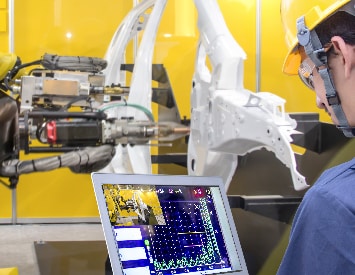When discussing visionary architecture and futuristic urban planning, few names shine as brightly as Buckminster Fuller. A polymath of the 20th century, Fuller’s innovative ideas and concepts continue to captivate the imagination of architects, urban planners, and engineers alike.
One of his most audacious ideas was that of “flying cities”, an extraordinary vision that challenged conventional notions of urban living and transportation.
The Origins of the Idea

Buckminster Fuller, often referred to as “Bucky”, was an architect, engineer, inventor, and philosopher.
He was known for his revolutionary ideas, many of which centered around sustainability, efficiency, and forward-thinking design.
His intellect was formidable, seeing him serve as the second World President of Mensa International from 1974 to 1983.
Fuller developed numerous inventions, mainly architectural designs, and popularized the widely known geodesic dome (a building that looks like a sphere cut in half, composed of triangular supports); carbon molecules known as fullerenes were later named by scientists for their structural and mathematical resemblance to geodesic spheres.
In the 1960s, during the height of the Space Race and the burgeoning exploration of space travel, Fuller proposed the concept of creating airborne cities. These cities would hover above the Earth’s surface, suspended by buoyant platforms or airship-like structures. Fuller believed that by moving cities to the skies, we could liberate land for agricultural use, reduce pollution, and mitigate the challenges of urban congestion.
The Mechanics of a Flying City
At the core of Fuller’s concept were lightweight, structurally efficient geometries.
His patented geodesic domes served as inspiration for these flying habitats. These lightweight structures would be tied to the ground by strong cables or anchored to buoyant platforms, allowing them to remain in the air.
The key to the concept’s feasibility lies in the principle of aerostatics. By utilizing the lifting power of gases or heated air, Fuller envisioned these cities floating gracefully above the landscapes. He believed that advances in materials science and engineering could provide the necessary strength-to-weight ratios for such ambitious structures.
It would be a half-mile diameter geodesic sphere that would weigh only one-thousandth of the weight of the air inside of it. If the internal air was heated by either solar energy or even just the average human activity inside, it would only take a 1-degree Fahrenheit (0.56 degree C) shift over the external temperature to make the sphere float.
Since the internal air would get denser when it cooled, Fuller imagined using polyethylene curtains to slow the rate at which air entered the sphere. He wanted to build Cloud 9s and anchor them in the mountains or let them drift so their inhabitants could see the world.
He calculated that such a balloon could lift a considerable mass, and hence that ‘mini cities’ or airborne towns of thousands of people could be built in this way.
A Cloud 9 could be tethered, free-floating, or maneuverable so that it could migrate in response to climatic and environmental conditions, and provide emergency shelters.
It was also discovered that geodesic spheres become stronger as they become bigger, because of how they distribute stress over their surfaces. As a sphere gets bigger, the volume it encloses grows much faster than the mass of the enclosing structure itself.

Not only would the structures hold their own weight, but these spheres could also house people, their belongings, and an entire infrastructure of buildings inside.
Environmental and Societal Implications
Fuller’s flying city concept was not merely an exercise in architectural aesthetics. He saw it as a solution to pressing environmental and societal issues. By moving urban centers to the skies, the ground could be dedicated to agricultural production, reducing pressure on natural resources. Additionally, pollution caused by industrial activities would be displaced from inhabited areas.
The concept also aimed to address urban sprawl and congestion, which were already becoming evident in the mid-20th century. Fuller’s flying cities could potentially ease the strain on existing infrastructure and provide a canvas for reimagining urban life in innovative ways.
Legacy and Lessons
Though the idea of flying cities might seem fantastical, it epitomizes Fuller’s capacity to push the boundaries of imagination.
While the concept itself has not been realized in its entirety, elements of Fuller’s visionary thinking have found their way into modern architectural and urban planning discourse.
The development of lightweight materials advances in sustainability, and the exploration of modular and adaptable urban structures owe a debt to Fuller’s pioneering ideas. His legacy reminds us that even the most radical concepts can inspire incremental progress and reshape our perspectives on the built environment.
Buckminster Fuller’s flying city concept remains an enduring symbol of human ingenuity and innovation. While the idea of cities suspended in the sky might remain a distant dream, its core principles of sustainable design, efficient use of resources, and creative problem-solving continue to inspire architects and urban planners as they strive to shape a better future for our rapidly changing world. Just as Fuller challenged the norms of his time, his legacy challenges us to imagine new possibilities for the cities of tomorrow.


